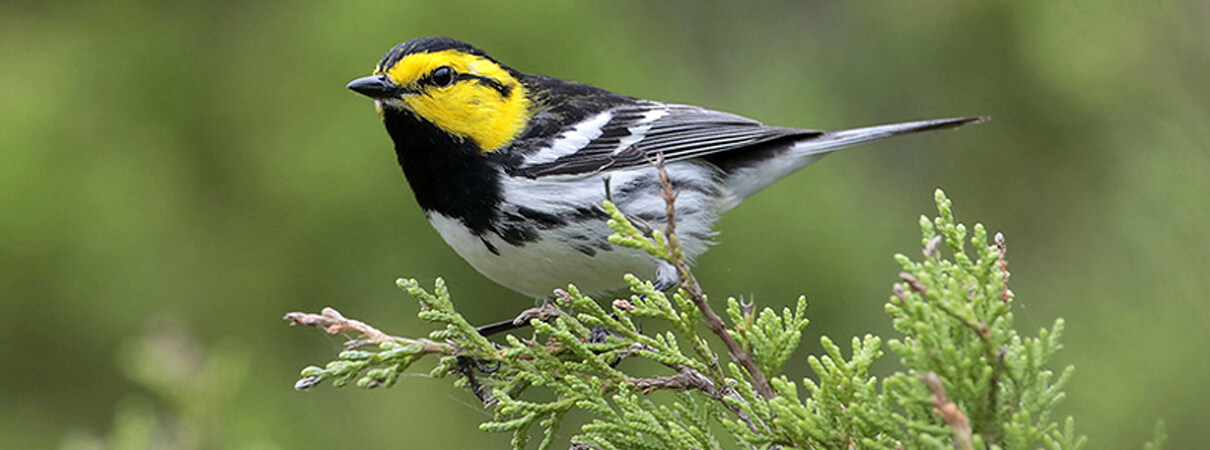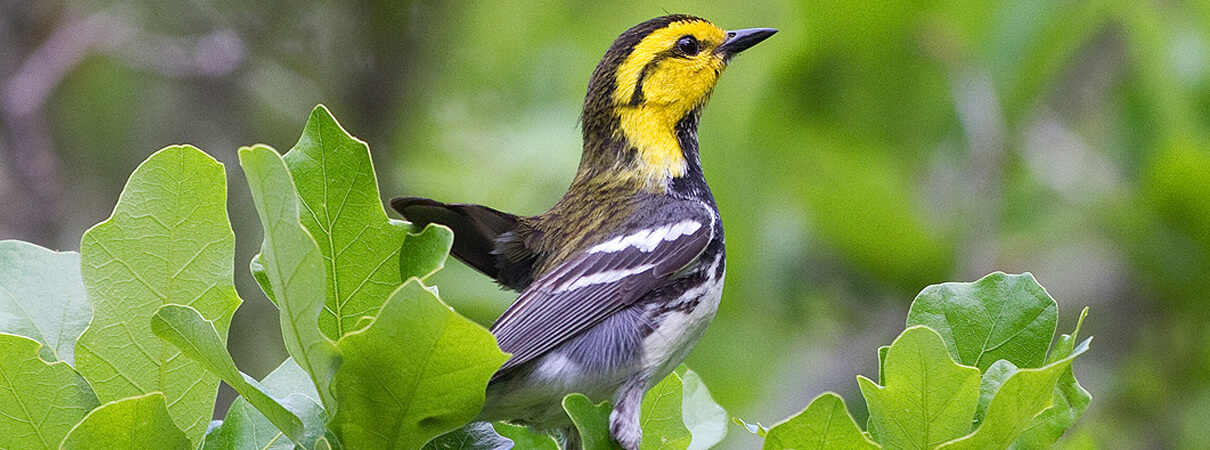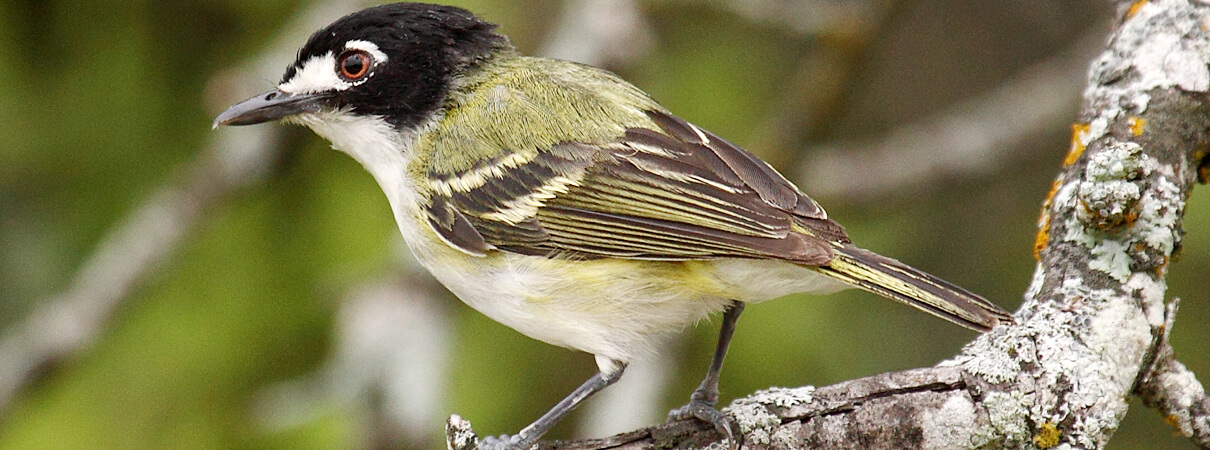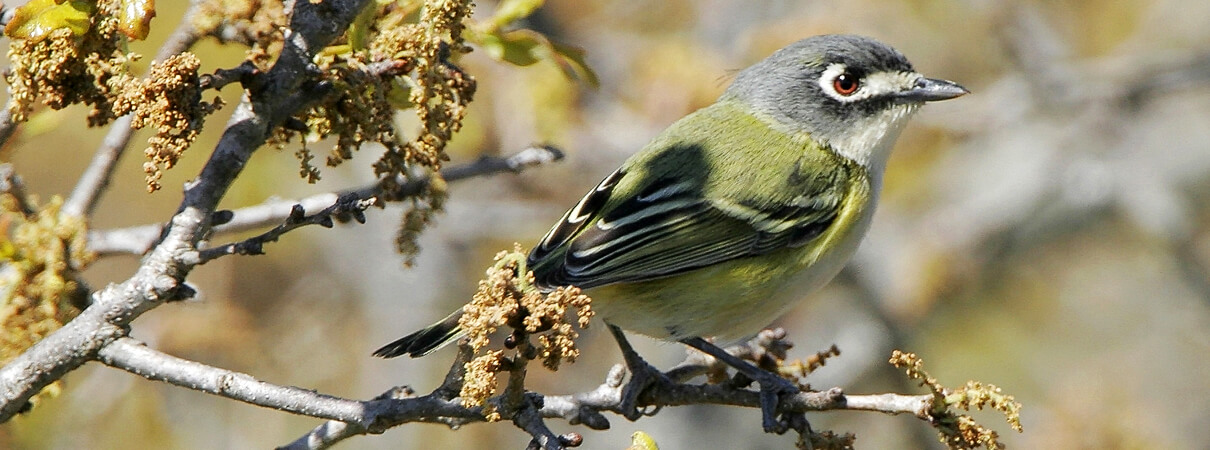Texas' Fort Hood Is an Unlikely Haven for Golden-cheeked Warbler, Other Songbirds
War transformed the nature of farmlands of central Texas. During World War II, what had been a landscape checker-spotted with oak-juniper woodlands turned into a busy Camp Hood. This had some unexpected results for wildlife, including the endangered Golden-cheeked Warbler.

The Golden-cheeked Warbler has beneifited from preservation of its habitat at Fort Hood in Texas. Photo by Greg Lavaty
The temporary military camp later became the permanent Fort Hood, the largest U.S. Army facility in the nation. The facility encompasses over 218,000 acres and supports more than 371,000 people, including some 50,000 soldiers.
Today, live weapons fire from helicopters, the roar of mechanized combat vehicles, and the clomp of tanks rumbling over the terrain like massive bulldozers with cannons are all common sights and sounds at Fort Hood.
And as of late, two songbirds are also increasingly common: the Golden-cheeked Warbler and the Black-capped Vireo. In seemingly incongruent fashion, the wispy songs of these two federally endangered birds sweeten the springtime air of Fort Hood.
Golden-cheeked Warbler: Native Texan
The Golden-cheeked Warbler wears a splash of yellow on its head with the panache of an officer of old. As showy as it is, the warbler has been listed as endangered under the Endangered Species Act since 1990. The bird is a true native Texan: its breeding range is entirely within the Lone Star State, including Fort Hood.
Throughout the bird's historic range, habitat loss through conversion of natural areas to parking lots and housing subdivisions, and urbanization in general, caused the bird's numbers to decline. Having a fair amount of habitat on a military installation has been a boon for the bird.
When the warblers return from their wintertime haunts in Mexico and Central America, nesting habitat at Fort Hood welcomes them home. The number of birds on the fort is on the rise, and it's not been by accident.

The number of Golden-cheeked Warblers at Fort Hood has been on the rise. Photo by Ryan Shaw
The warbler was discovered on Fort Hood lands in the 1950s. Biologists, seeing the conservation need, recommended to the fort's commanding general in 1970 that blocks of land be set aside for the bird. The Army abided.
Home for Breeding Vireos
In the 1980s, another bird species came into view. Surveys by scientists revealed that the Black-capped Vireo was declining in the northern part of its summertime breeding range, which included Fort Hood.
The vireo's numbers have dwindled for many of the same challenges facing the warbler. Nest parasitism is a problem, as well; Brown-headed Cowbirds, a native bird species, make no natural effort to build a nest and raise their own offspring, letting other bird species do it for them—including the vireo.
The Black-capped Vireo sports its namesake black “cap” and what looks like white spectacles bridging its face. The birds sing an emphatic song perched in stands of shrubby oaks, where they build intricate hanging cup nests fastened with spider silk. They eat bugs and spiders gleaned from leaves and tree branches, sometimes deftly hovering while doing so.

Numbers of Black-capped Vireo have grown at Fort Hood, to the point that the population is difficult to accurately assess. Photo by Gil Eckrich
An Unexpected Partnership
The vireo was listed as endangered in 1987. Two years later, surveys revealed 143 males living on Fort Hood. Their numbers grew, and in the 1990s, the population on Fort Hood was too large to accurately assess. By 2014, an estimated 7,500 male Black-capped Vireos were living on Fort Hood. The U.S. Fish and Wildlife Service, recognizing these accomplishments, greatly appreciated the unexpected conservation partnership with Fort Hood.
The Golden-cheeked Warbler has seen similar increases. Just this past year, biologists estimated there were 7,382 male warblers on the fort. Indeed, Fort Hood is home to the largest known population of these warblers and vireos.
This is particularly noteworthy considering that most of the vireo's summer range and all of the warbler's summer range exists in Texas, where 97 percent of land is privately owned.

New threats to Black-capped Vireo have been uncovered at Fort Hood, thanks to the use of miniature video cameras that monitor nests. Photo by Greg Lavaty
Fort Hood has been a willing and eager partner in conservation of these rare birds for almost a quarter century.
"Our goal has always been to make the endangered species at Fort Hood invisible to the soldier training on the installation. Now, with the help of the Service, the next version of the training maps does exactly that,” said Tim Buchanan, Fort Hood's Chief of Natural and Cultural Resources.
As a result of more than two decades of research and conservation work at Fort Hood on the vireo and warbler, today the base operates without the training restrictions that had previously been in place.
Scientific Advances for Endangered Songbirds
The fort has also welcomed scientists from academia and government agencies to conduct research. Thanks to Fort Hood's cooperative approach, the science available to advance conservation efforts for the warbler and vireo, as well as many other species found at Fort Hood, has flourished.
For instance, the use of miniature video cameras to monitor vireo nests at the facility revealed that Texas rat snakes are significant predators of vireos on the nest—something previously unknown to science.
Research on the birds benefits the Army, too. Staff have learned that the natural habitats these species use are necessary to sustain lands used for training soldiers. Tanks and artillery fire are hard on the land. Managing for healthy native habitat on the fort is an essential task for terrain that regularly accommodates a high volume of military exercises.

Bradley tank at Fort Hood. Photo by Gil Eckrich
Fort Hood's efforts have helped the Service meet—and by some measures, exceed—its population recovery goals for both bird species.
“The Service greatly values our partnership with Fort Hood. They have gone above and beyond to work with us and to address the conservation needs of the Golden-cheeked Warbler and Black-capped Vireo,” said Omar Bocanegra, a Service biologist.
“Thanks to the cooperative relationship between the Service and Fort Hood, we have greatly enhanced the information on both species. They've clearly demonstrated that it is possible to successfully manage endangered species and military preparedness.”
Most important, Fort Hood has demonstrated that natural resources entrusted to the Department of Defense's care are not only sustained, but can be improved, all while ensuring that military training and testing are uncompromised.
Fort Hood serves as a model for other military installations across the country, clearly demonstrating that national defense and conservation are not mutually exclusive.
Craig Springer and Lesli Gray are Public Affairs Specialists with the U.S. Fish and Wildlife Service. They both work in the Service's Southwest Region office in Albuquerque, N.M.


















































